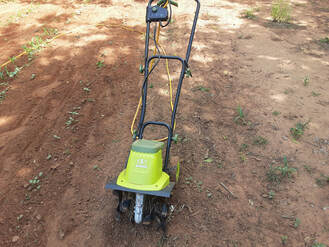|
One of my greatest joys is planting a garden each year. Do all minimalists have gardens? I think not, but there are lots of reasons why I plant and harvest from my garden during the spring, summer, and fall. Two of my best friends at church were talking with me Sunday about the garden. One fellow agreed that growing your vegetables was the way to go, but another thought it was a lot of work for minimal reward. His opinion was that he could get all the fresh fruits and vegetables at the Farmers Market here locally. While that is true, it does cost money, and you truly don’t know what chemicals were used in raising the plants. By growing them yourself, you know exactly what you used and if they are safe to eat. Advantages of Gardening Great Exercise All of us can use a little exercise. I find the time well-spent and feel better after I work for an hour or so in the garden. Nurturing of Your Soul I have a feeling of comfort that comes over me when I work on planting the seed and watching them sprout and become fruit-producing plants. The watering and cultivating have a calming effect on me on the sometimes chaotic days at work. Fruits for Labor We have the promise that we will reap what we sow it says in the book of James. While that is a spiritual connotation, it is also true in farming and gardening. You plant a few seeds, and you reap a bountiful harvest. You Control Chemical Usage As mentioned earlier, it is not good to have chemicals used to kill weeds entering the body. When we control the environment, we know what has been used and when. I try to grow plants without any chemical use, but sometimes Squash bugs may require a bit of Seven Dust. If so, I make sure that we wait a period of time before harvesting the squash and wash it thoroughly. Tastes Great I ate my first banana pepper at lunch. It may not have been better than others of the past, but being the first fruits from this year’s garden made it super sweet. I think that food grown in the garden is the best tasting food ever. Teaches Another Generation I raised my children to help work in the garden, and two of three of them have their own gardens today. Now another generation has passed and I work with my second set of grandchildren(younger ones) to rototill and plant the seeds each spring. It teaches them good husbandmanship and it allows them to make a few dollars working for me in the spring and fall. (When we rototill the garden for winter.) Gardening has long been in my family. My maternal grandfather used to keep a one-half acre garden each year and he did it with no plows or any kind of tiller. He had a worn-out hoe that he had used in his farming days, and he would sharpen that hoe and work like crazy. If we came over to see him early, he was out watering and hoeing. If we came over late, he was still out there working, even on the 100-degree days. I fondly remember seeing the twenty or thirty large watermelons lined up on my grandparent’s back porch, and no one could go home without loading up with a few cantaloupe and watermelons. What is your first childhood memory? My very first one is sitting in a high chair in our country kitchen in the country near Vera, Texas with my mother feeding me scrambled eggs. I remember it so vividly as I would pour ketchup all over the eggs. It is funny thinking of a 2-year-old eating scrambled eggs with ketchup. It does not sound tasty to me today. However, my second childhood memory is watching my dad (who was a farmer), use a turning plow to prepare our garden west of the house using a Jubilee Ford Tractor. I was probably 2 ½ or 3 years old, and I was so fascinated to see that dirt turn over as my dad prepared the ground to plant in our orchard. All through my childhood and up into my teenage years, my childhood responsibilities included picking the vegetables, watering, and hoeing out the weeds. (Which I did not really like doing.) But when the vegetables came in, boy I loved eating them. Nothing like homegrown radishes, tomatoes, black-eyed peas, and onions. Fried Squash and fried okra were staples in our home. The pictures below were taken in my garden. You can see the plants beginning to grow. On the left, you can see squash plants and black-eyed peas on the right. Notice the tomatoes growing on the tomato plant in the second picture. I have used electric Sun-Joe tillers for the past five years. I purchased a 16” model 3 years ago and replaced it this year with the 12” model which cost less than $150. It requires less voltage so a 12 gauge extension cord will work, and it is a bit narrower which allows you to plant a bit more closely together and still till between the rows. I just tilled the whole garden this morning in about 30 minutes. Gardening is a personal decision that only you can make. If you have decided to try and simplify your life, I think it is a great way to get some exercise and enjoy the fruits of your labor. It can turn into a bit of work, but I find it worth the effort. If you are limited on space, you might consider using pots or bins. Many people use raised bins and grow many vegetables each year, including my daughter and her husband. List of All Investment Articles List of All Minimalism Articles Internet Direct Laptops
0 Comments
DISCLAIMER - I am not a Financial Advisor and do not work for any Brokerage Firm. The opinions given are my own and are not to be used as professional advice. These are my findings and can hopefully help you make informed decisions on investing. Consult a Broker or Lawyer before making any investment. Back to Basics – Part 2 We began our study on getting back to the basics of Investing last week. If you did not read that article, I suggest you read it first. It is the first article on our new blog site: LifeCanBesimple.blog Back to Basics in Investing Part 1 We have dozens of articles on our old site which is LifeCanBeSimple.net I mentioned last week it is important to know HOW TO INVEST, and also what platform to use to invest. Anyone can open a standard brokerage account, but you have so many things to consider concerning your taxes. If possible, always do your investing in either a 401-K plan or a Roth IRA, or a Traditional IRA. If your employer offers a 401-K, you probably want to start investing there. Most companies will match your first 3 to 5% of your contributions. That means you will immediately have a 100% gain on the money the company matches into your account. An example of a 3% company match would be if you put in 3% of your $20,000 salary. Your contribution for the year would be $20,000 * .03 percent which would be $600. The company would also contribute $600 making your total year-end balance equal to $1200 plus any dividends or gains you might have had. Not all companies have a match, but if they do, you sure want to contribute up to that matching amount if possible. Also, realize that companies may not pay their portion of the earnings until you are fully vested. Talk with your HR department or a lawyer or tax planner to fully understand vesting. If no matching is available on a 401-K, consider investing in an Individual Retirement Account (IRA). There are two types, the Traditional IRA and the ROTH IRA. I am using ROTH IRAs on all 5 of the ones my wife and I currently have, but you may be better off taking the tax deduction on the traditional IRA if you expect to have a lower tax bracket at retirement. DIFFERENCES in IRAs Investing requires patience. Warren Buffet, one of the world's most well-known investors, said: “Wealth is a transition of money from the impatient to the patient.” Unless you have patience, you most likely will not do well in investing. You need to look at the ‘big long-haul picture.” Some people spend all their time looking for a fast dollar. The best way to make money is to study and be slow and methodical. Not losing money should be your number one goal. When making investments, it is crucial to invest using a Retirement Account. If you don’t invest in a retirement account, you will have to pay taxes on both your dividends and your capital gains or losses. A capital gain or loss happens when you sell an investment for more or less than what you originally paid for it. If you held that investment for over a year, you have a long-term capital gain or loss. If less than a year, it is a short-term capital gain or loss. There is a substantial difference in the amount of taxes you have to pay. Long-term gains are taxed at your current tax rate. Short-term gains are at a higher rate. When you own an asset or investment for one year or less before you sell it for a profit, that’s considered a short-term capital gain. In the U.S., short-term capital gains are taxed as ordinary income. That means you could pay up to 37% income tax, depending on your federal income tax bracket. You must study tax laws to determine the exact price. When investing with a retirement account, you don’t have to concern yourself with capital gains. If invested in a ROTH IRA, you will never pay taxes on your profits. On Traditional IRAs and 401Ks, when taking a distribution, you pay income tax as you take the withdrawals. It is up to you to make good decisions and study to make wise investments. I loved what Jim Rohn, a motivational speaker said. “If you don’t like the way things are, CHANGE. You are not a tree” Be smart. If you are not pleased with where you are in life, CHANGE. Change your habits and get on a steady, consistent path. What is a good investment plan? If you read 20 different investment blogs or books, I dare say all will be different. Who is right? There are many voices crying out for our attention. The Bible says that none of those voices are without signification, meaning they are either good or bad. I listened and tried dozens of them over the past 30 years. Last year I got really serious and started reading, and I mean a lot. Last year I read 90 books, and this year by June I have read 52 books. Every book has been about investments, mindset, or habits. And all have helped me to get a better idea on how to invest. Is my plan best for you? I can not guarantee you it is the best. However it is a combination of about 20 different plans that I have put together. Here are 4 common methods to invest. Plan 1 – Use a certified financial planner (CFP) to make your decisions and put together a logical plan. There is a charge for this service. It can be a fixed amount but normally is tied to the total investment value which ranges from 1 to 5%, sometimes even higher. One thing to be on the lookout for is that the person making the decisions is not making a profit on the funds or stocks they have you invest in. This is my least favorite plan as I am a hands-on person and want control over what I invest in. Plan 2 – Manage yourself and buy mutual funds that have done well over the years. Magazines like Kiplingers have lists of good quality mutual funds with ratings and percentages they have averaged over 1, 3, 5, and 10 years. Pay more attention to 3 and 5-year averages than just recently, as the market may have been down and all funds dropped during that period. Mutual funds are categorized into many groupings. Some are total bonds, some are Large Growth funds, and some are balanced funds with both types. There are small-cap mutual funds, medium-cap, etc etc. Plan 3 – Control it yourself, and invest mainly with ETFS. (Exchange Traded Funds) Investing with ETFs. You do not have to pay high management fees and can get every flavor of investments in the various ETFs. On these, always put a large number of your investments in the total stock market using ETFs like ITOT, SCHB, or VTI. You can mix in specific industries, bonds, Real Estate Investment Trusts (REITs), and dividend growth stocks. Reits and M-Reits There are so many flavors of ETFs that I need to write an article on the many types available. This is one of my best ways to invest. Plan 4 – Purchase a mix of them all. Buy Mutual Funds and Bonds for stability, Then buy a lot of ETFs, and then get into the deeper methods of investing in Preferred Stocks, Block Development Companies, Closed-End Funds, and REITs. And you always want to invest in Dividend Growth Stocks. Understanding Preferred Stocks Using the Preferred Stock Channel Explanation of Business Development Companies Investing with Dividend Growth Stocks My current investment portfolio is tied mainly to this method with a heavy dose of Preferred Stocks and CEFs purchased at large discounts to Net Asset Value. Many of these are paying 12 to 30% in dividends. www.preferredstockchannel.com/ I have used all four of these methods and what works best for you may be any one of them or a combination of the others. The reason for my success in late 2022 and 2023 has been the limiting of loss of down markets using Stop Loss orders. Protecting Your Investments from Huge Losses Another method many use is to buy the same amount of a specific investment continuously. (Like weekly or monthly). This allows you to have dollar cost averaging. In high markets you buy fewer shares but more in low markets. A person using this concept is Rachel Richards, the author of Money Honey. She says she has four rules on investing, which can not always be taken into account when doing dollar cost averaging. Rule #1 – Don’t Sell when the Market is Down. Rule #2 – Don’t buy when the Market is High. Rule #3 – Hold investments for over one year before selling. Preferably for over 5 to 20 years. Rule #4 – Don’t be a control fanatic. She has followed her rules and has done very well. She only reallocates her investments twice a year. She invests using auto-pilot and lets it run itself. She uses just 4 ETFs and puts 25% of her monthly investment into each of these categories. 25% to Small Growth Stocks 25% to Mid Cap Growth Stocks 25% to Large Cap Growth Stocks 25% to Global/International funds. The 4 ETFS she mentioned that she has used were: IJR VO VV VEA The last 3 are Vanguard ETFs. You might make it 20% and put the last 20% in VTI to make an even more diverse portfolio. VTI is the total stock market index. So I guess we will close the second article on getting back to the investments. What you do is really up to you. There is no perfect investment plan, but there are many, many ways. What I advise you to do is this. Study, and then study some more. Try things. Don’t be afraid to have a few failures. I learned that from several of Robert Kiyosaki’s books. I have not given up when I have had failures. I kept at it and learned. You can too. Is it easy? No. But you can be successful. You are not defeated until you fail to get back up. Stick to it. Be determined. List of All Investment Articles List of All Minimalism Articles Internet Direct Laptops
DISCLAIMER - I am not a Financial Advisor and do not work for any Brokerage Firm. The opinions given are my own and are not to be used as professional advice. These are my findings and can hopefully help you make informed decisions on investing. Consult a Broker or Lawyer before making any investment. Back to Basics – History from Cash to Mutual Funds The years 2022 and 2023 have been quite a trip regarding Investments. In early 2022, the S&P 500 was down over 30%. To say there were challenges in investing in 2022 is a vast understatement. The purpose of our blog is to help investors get started in investing. Several of you have mentioned that my most recent articles on investing have become a bit complex covering tougher subjects like Preferred Stocks, BDC (Business Development Companies), and CEFs. (Closed-End Funds.) The complexity certainly has not been on purpose. My goal is to help everyone find the niche they need to make money consistently. Like all endeavors, we must continue to grow and expand our knowledge so that we can apply what we have learned to gain the maximum returns. This is not something you learn once and never need to expand or grow for the rest of your life. So for those of you who are not ‘seasoned investors’, this week is for you. We are going to take a historical view of money and how we got to where we are today. We won’t go back to Genesis 1:1 where God spoke the earth and man into existence, but we will begin talking about the simplicity of cash. The original method of exchanging money for goods was done simply with cold hard cash. If a horse cost $10 in the olden days, you pulled out ten one-dollar bills and made the purchase. Banks came along and allowed people to store their money safely and later started savings accounts where they paid you money for the use of your savings dollars. As banks got into making loans, they then started offering CDs. (Certificate of Deposits). This tied up your money for terms of a few months to five years. If you took the money out before the maturity date of the CD, you paid a penalty which is still how it is done today. The first stock market began in the 1400’s, but the New York Stock Exhange began in 1790. So early on, companies began selling stock certificates to allow people to invest in their company. Back then it was a physical certificate, but today computers keep up with who owns the many shares of stock. Many companies began paying dividends on their profits, making it more profitable to own the stocks. Dividend-paying stocks are still one of the best investments out there. The high-quality companies began to be known as Blue Chip companies (where the term blue chip stocks originated.) They pay 1% to 15% in quarterly dividends. A stock is simply a unit of ownership in the company. If you own IBM stock, you own a part of the IBM Corporation. There are many elements to the stock market. Stocks are very liquid and also fluctuate in price a lot. In one day they might go from $95 a share to $120 and then close the day at $90. The 3 main indices of the stock market are the DOW (Top 30 stocks), the NASDAQ consisting mainly of 100 technology stocks, and the S&P 500 which are some of the largest 500 stocks. Different rules apply on who makes up these 3 lists and changes do happen year to year as to which companies make up those indices. One of the great things about stocks is they can theoretically go up and up, but the most you can ever lose is the amount you paid for the stock. There is no liability associated with owning stock, so you will never be sued for corporate wrongdoing when you own stock. You can lose your full investment (which is rare), but that is the maximum loss. Some of the Investment Categories Soon another monetary element came along called a bond. A bond was an IOU from the company paid to the bondholder. It was a debt the company was to pay the bondholder and had various maturity dates such as one to 5 years. A bond is an IOU from the company to you the bond holder. Again in the early days, there were bonds with coupons to cut out to get your monthly or quarterly interest. Today computers keep up with the ownership of the bonds and no real coupons exist. The bond market is even bigger than the stock exchange. Bonds are not as volatile in price as stock, but as interest rates change, they can move up and down rapidly in price. A Treasury bond that has 30-year maturity will go down substantially in price when interest rates rise but will go up in value when interest rates drop. All maturities fluctuate, but the 30-year maturities move the most due to the time they have to be held until maturity. What is a bond? The Pros of bonds are they are less volatile and offered in many different maturities. You can buy 90-day Treasury bills and notes, and go out to 30 years on Treasury Bonds. Corporate bonds typically are not for more than 10 years. So bonds offer less volatility and more stability. As a person nears retirement age, owning more bonds gives your portfolio more stability. One of the better investments in 2022 was the I-Bond. These are inflation-protected treasury bonds that are tied to a 30-year bond rate plus the inflation rate. In April of 2022, these were paying 9.62%, but have since dropped each six months to the current rate of 4.3%. But still not too shabby for a government backed security. Information on I-Bonds and How to buy at treasurydirect.gov The Cons of bonds are that they normally pay less than what Stocks will pay you over time. Since stocks are volatile, it means you must have holdings in many companies to diversify. That is when Mutual Funds were created. By buying into a mutual fund, you are buying a portion of many stocks and/or bonds. When you buy a share of a mutual fund, it automatically gives you a lot of diversification. Some mutual funds are just for specific types of stocks, some just for bonds of various maturities, and then some that are called balanced funds that own both Stocks and Bonds. These sort of became the marketplace gems in the early years of the 70s and 80s. You paid the manager of the fund a fee to manage your investments. These fees could be as low as 2% but some much much higher. Today most are sold as no-fee mutual funds, but while no upfront fee is paid, there are still management fees of 1 to 2%. What investors discovered after much study was that most fund managers can not beat the average of the overall stock market. That is when Mutual Index Funds began being sold that tracked stock market indexes. These were not truly managed funds so the fee was less. Vanguard Investments is known for its low-priced index funds. Someone came up with the idea of making a type of investment that was not a mutual fund, but just an index. These became known as ETFs (Exchange Traded Funds), and they have almost no fee involved. Normally 2% and most under 1%. So if you buy an ETF like VTI (Vanguard Total Index ETF), you are tracking ALL the stocks in the whole stock market. A great simple way to save money and get consistent returns. Many say that the average return on the full stock market over the last 50 years is 12% or higher. Be aware that there are many times that the stock market has lost money for 3 consecutive years. But on average, stocks and ETFs are a good way to invest when tied to the index of the whole stock market or dividend-paying stocks. ETFs are one of the most popular investment vehicles in investment circles. You can sell them anytime the market is open. The ETF price reflects the whole market segment they represent. You must realize that there is an ETF to track almost any type of investment nowadays So what we are talking about being safer is FULL MARKET indexed ETFs like VTI, ITOT, and SCHB. SPY is another good one for the S&P 500 only stocks. Simple Path to Invest using ETFs. It is amazing how much you must talk about to make basic investing simple. It simply cannot be done in one article. I think we need to continue on this next week and explain a bit about capital gains and how to shelter your retirement from income taxes. You will not fully understand all of the options in the stock market without studying for several years. All of the articles on our Investment Page can help identify various methods to invest. List of All Investment Articles Thank you for your patience. It truly takes an investment professional to help you fully understand what is involved and the tax concerns of investing. Your lawyer or investment broker can shed more light on the complexities. You must study and grow to be effective in investing. We began last year with many basic articles if you go to the bottom of our Investment Articles list and work your way up. List of All Investment Articles List of all Minimalism Articles Internet Direct Laptops
|
David ParhamChristian Minimalist and Investor. God guides and helps me everyday. Archives
May 2024
Categories |
||||||||||||||||||







 RSS Feed
RSS Feed
